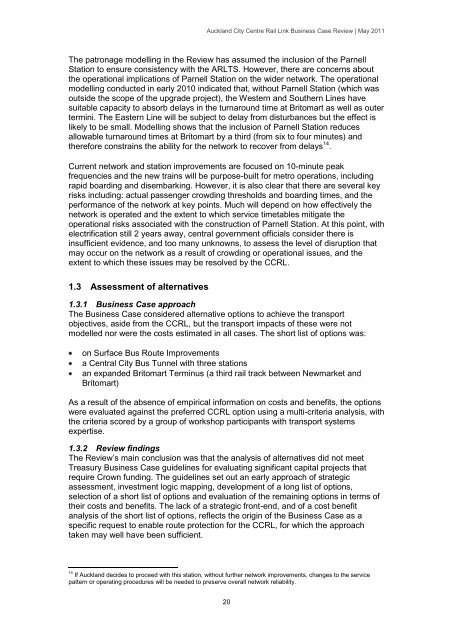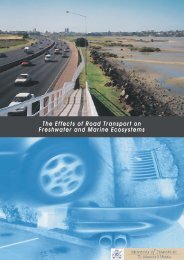Auckland City Centre Rail Link - Business Case Review - Ministry of ...
Auckland City Centre Rail Link - Business Case Review - Ministry of ...
Auckland City Centre Rail Link - Business Case Review - Ministry of ...
Create successful ePaper yourself
Turn your PDF publications into a flip-book with our unique Google optimized e-Paper software.
<strong>Auckland</strong> <strong>City</strong> <strong>Centre</strong> <strong>Rail</strong> <strong>Link</strong> <strong>Business</strong> <strong>Case</strong> <strong>Review</strong> | May 2011<br />
The patronage modelling in the <strong>Review</strong> has assumed the inclusion <strong>of</strong> the Parnell<br />
Station to ensure consistency with the ARLTS. However, there are concerns about<br />
the operational implications <strong>of</strong> Parnell Station on the wider network. The operational<br />
modelling conducted in early 2010 indicated that, without Parnell Station (which was<br />
outside the scope <strong>of</strong> the upgrade project), the Western and Southern Lines have<br />
suitable capacity to absorb delays in the turnaround time at Britomart as well as outer<br />
termini. The Eastern Line will be subject to delay from disturbances but the effect is<br />
likely to be small. Modelling shows that the inclusion <strong>of</strong> Parnell Station reduces<br />
allowable turnaround times at Britomart by a third (from six to four minutes) and<br />
therefore constrains the ability for the network to recover from delays 14 .<br />
Current network and station improvements are focused on 10-minute peak<br />
frequencies and the new trains will be purpose-built for metro operations, including<br />
rapid boarding and disembarking. However, it is also clear that there are several key<br />
risks including: actual passenger crowding thresholds and boarding times, and the<br />
performance <strong>of</strong> the network at key points. Much will depend on how effectively the<br />
network is operated and the extent to which service timetables mitigate the<br />
operational risks associated with the construction <strong>of</strong> Parnell Station. At this point, with<br />
electrification still 2 years away, central government <strong>of</strong>ficials consider there is<br />
insufficient evidence, and too many unknowns, to assess the level <strong>of</strong> disruption that<br />
may occur on the network as a result <strong>of</strong> crowding or operational issues, and the<br />
extent to which these issues may be resolved by the CCRL.<br />
1.3 Assessment <strong>of</strong> alternatives<br />
1.3.1 <strong>Business</strong> <strong>Case</strong> approach<br />
The <strong>Business</strong> <strong>Case</strong> considered alternative options to achieve the transport<br />
objectives, aside from the CCRL, but the transport impacts <strong>of</strong> these were not<br />
modelled nor were the costs estimated in all cases. The short list <strong>of</strong> options was:<br />
on Surface Bus Route Improvements<br />
a Central <strong>City</strong> Bus Tunnel with three stations<br />
an expanded Britomart Terminus (a third rail track between Newmarket and<br />
Britomart)<br />
As a result <strong>of</strong> the absence <strong>of</strong> empirical information on costs and benefits, the options<br />
were evaluated against the preferred CCRL option using a multi-criteria analysis, with<br />
the criteria scored by a group <strong>of</strong> workshop participants with transport systems<br />
expertise.<br />
1.3.2 <strong>Review</strong> findings<br />
The <strong>Review</strong>‘s main conclusion was that the analysis <strong>of</strong> alternatives did not meet<br />
Treasury <strong>Business</strong> <strong>Case</strong> guidelines for evaluating significant capital projects that<br />
require Crown funding. The guidelines set out an early approach <strong>of</strong> strategic<br />
assessment, investment logic mapping, development <strong>of</strong> a long list <strong>of</strong> options,<br />
selection <strong>of</strong> a short list <strong>of</strong> options and evaluation <strong>of</strong> the remaining options in terms <strong>of</strong><br />
their costs and benefits. The lack <strong>of</strong> a strategic front-end, and <strong>of</strong> a cost benefit<br />
analysis <strong>of</strong> the short list <strong>of</strong> options, reflects the origin <strong>of</strong> the <strong>Business</strong> <strong>Case</strong> as a<br />
specific request to enable route protection for the CCRL, for which the approach<br />
taken may well have been sufficient.<br />
14 If <strong>Auckland</strong> decides to proceed with this station, without further network improvements, changes to the service<br />
pattern or operating procedures will be needed to preserve overall network reliability.<br />
20
















